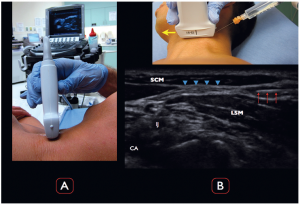
Explore This Issue
ACEP Now: Vol 33 – No 11 – November 2014(click for larger image)
Figure 4.
A) The ultrasound screen is contralateral to the affected extremity, with a clear view of the screen for the clinician. B) The needle and needle tip (red arrows) are visualized clearly entering from the lateral aspect of the ultrasound image. Note that the ultrasound transducer directional marker is medial (yellow arrow).
Anechoic anesthetic is being placed between the SCM muscle and LSM, with clear visualization of the needle tip as well as the SCP (blue arrowheads).
Potential Complications. As with all ultrasound-guided nerve blocks, systemic toxicity from inadvertent vascular injection and peripheral nerve injury should always be considered. Specifically for the ultrasound-guided SCP block, if the provider chooses a level too low (C6) or too deep (beneath the prevertebral fascia), phrenic nerve, recurrent laryngeal nerve, deep cervical plexus, or brachial plexus block can occur. Also, a transient Horner’s syndrome can occur if the anesthetic travels deep in the prevertebral fascial plane and reaches the cervical sympathetic chain. Even though uncommon, understanding possible unwanted side effects is imperative for any clinician performing the SCP block (or any procedure).
Dr. Nagdev is director of emergency ultrasound at Highland General Hospital in Oakland, California.
Dr. Herring is an attending physician at Highland General Hospital.
References
- Herring AA, Stone MB, Frenkel O, Chipman A, Nagdev AD. The ultrasound-guided superficial cervical plexus block for anesthesia and analgesia in emergency care settings. Am J Emerg Med. 2012;30:1263-7.
- Shteif M, Lesmes D, Hartman G, Ruffino S, Laster Z. The use of the superficial cervical plexus block in the drainage of submandibular and submental abscesses—an alternative for general anesthesia. J Oral Maxillofac Surg. 2008;66:2642-5.
- Çiftci T, Daskaya H, Yıldırım MB, Söylemez H. A minimally painful, comfortable, and safe technique for hemodialysis catheter placement in children: superficial cervical plexus block. Hemodial Int. 2014;18:700-4.
Pages: 1 2 3 | Single Page





One Response to “Pain Control Using Ultrasound-Guided Superficial Cervical Plexus Block”
October 19, 2021
Hazel McArdleCan ultrasound be used for scalene tight muscles